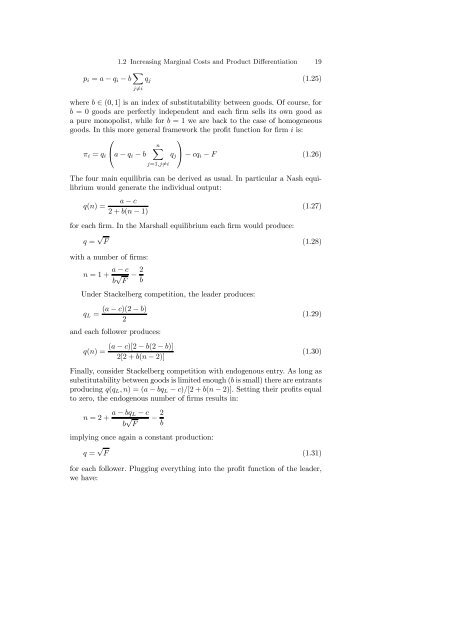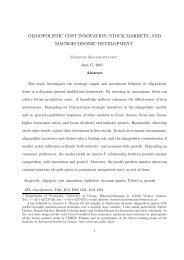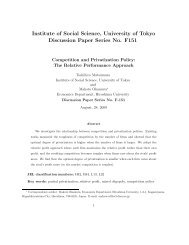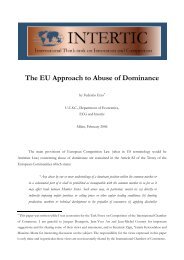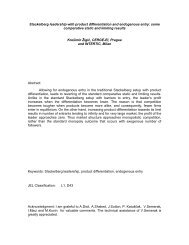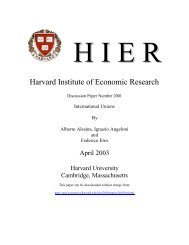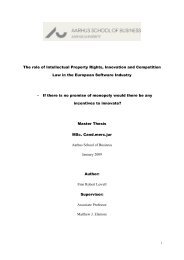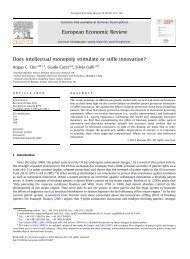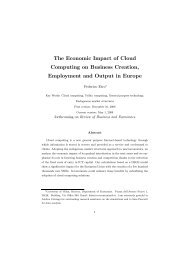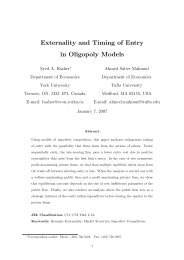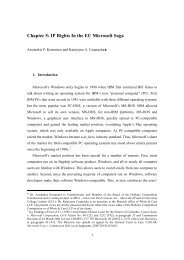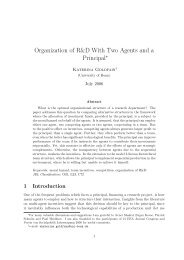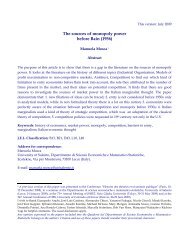- Page 1: Federico Etro COMPETITION, INNOVATI
- Page 6: A Francesca, Riccardo e Leonardo
- Page 9 and 10: viii Preface Michael Spence, Joseph
- Page 11 and 12: x Preface In Chapter 1, I introduce
- Page 13 and 14: xii Preface are always optimal); an
- Page 15 and 16: xiv Preface many topics, and my way
- Page 17 and 18: xvi Preface seen as a complement of
- Page 19 and 20: xviii Contents 2.10 Bundling ......
- Page 21 and 22: xx Contents Index .................
- Page 23 and 24: 2 1. Competition, Leadership and En
- Page 25 and 26: 4 1. Competition, Leadership and En
- Page 27 and 28: 6 1. Competition, Leadership and En
- Page 29 and 30: 8 1. Competition, Leadership and En
- Page 31 and 32: 10 1. Competition, Leadership and E
- Page 33 and 34: 12 1. Competition, Leadership and E
- Page 35 and 36: 14 1. Competition, Leadership and E
- Page 37 and 38: 16 1. Competition, Leadership and E
- Page 39: 18 1. Competition, Leadership and E
- Page 43 and 44: 22 1. Competition, Leadership and E
- Page 45 and 46: 24 1. Competition, Leadership and E
- Page 47 and 48: 26 1. Competition, Leadership and E
- Page 49 and 50: 28 1. Competition, Leadership and E
- Page 51 and 52: 30 1. Competition, Leadership and E
- Page 53 and 54: 32 1. Competition, Leadership and E
- Page 55 and 56: 34 1. Competition, Leadership and E
- Page 57 and 58: 36 1. Competition, Leadership and E
- Page 59 and 60: 38 1. Competition, Leadership and E
- Page 62 and 63: 2. Strategic Commitments and Endoge
- Page 64 and 65: 2. Strategic Commitments and Endoge
- Page 66 and 67: 2.1 Market Structure 45 Another wid
- Page 68 and 69: 2.1 Market Structure 47 More formal
- Page 70 and 71: 2.3 Marshall Equilibrium 49 dΠ dn
- Page 72 and 73: 2.4 Competition in Quantities, in P
- Page 74 and 75: 2.4 Competition in Quantities, in P
- Page 76 and 77: 2.4 Competition in Quantities, in P
- Page 78 and 79: 2.4 Competition in Quantities, in P
- Page 80 and 81: 2.5 Strategic Investments 59 Now, s
- Page 82 and 83: 2.5 Strategic Investments 61 If the
- Page 84 and 85: 2.5 Strategic Investments 63 dog st
- Page 86 and 87: 2.5 Strategic Investments 65 Basica
- Page 88 and 89: 2.6 Cost Reductions and Signaling 6
- Page 90 and 91:
2.6 Cost Reductions and Signaling 6
- Page 92 and 93:
2.7 Advertising and Demand Enhancin
- Page 94 and 95:
2.8 Debt and the Optimal Financial
- Page 96 and 97:
2.8 Debt and the Optimal Financial
- Page 98 and 99:
2.9 Network Externalities and Two-S
- Page 100 and 101:
2.10 Bundling 79 induce different s
- Page 102 and 103:
2.10 Bundling 81 Clearly, bundling
- Page 104 and 105:
2.11 Vertical Restraints 83 It is a
- Page 106 and 107:
2.12 Price Discrimination 85 suranc
- Page 108 and 109:
2.13 Antitrust and Horizontal Merge
- Page 110:
2.14 Conclusions 89 2.14 Conclusion
- Page 113 and 114:
92 3. Stackelberg Competition and E
- Page 115 and 116:
94 3. Stackelberg Competition and E
- Page 117 and 118:
96 3. Stackelberg Competition and E
- Page 119 and 120:
98 3. Stackelberg Competition and E
- Page 121 and 122:
100 3. Stackelberg Competition and
- Page 123 and 124:
102 3. Stackelberg Competition and
- Page 125 and 126:
104 3. Stackelberg Competition and
- Page 127 and 128:
106 3. Stackelberg Competition and
- Page 129 and 130:
108 3. Stackelberg Competition and
- Page 131 and 132:
110 3. Stackelberg Competition and
- Page 133 and 134:
112 3. Stackelberg Competition and
- Page 135 and 136:
114 3. Stackelberg Competition and
- Page 137 and 138:
116 3. Stackelberg Competition and
- Page 139 and 140:
118 3. Stackelberg Competition and
- Page 141 and 142:
120 3. Stackelberg Competition and
- Page 143 and 144:
122 3. Stackelberg Competition and
- Page 145 and 146:
124 3. Stackelberg Competition and
- Page 147 and 148:
126 3. Stackelberg Competition and
- Page 149 and 150:
128 3. Stackelberg Competition and
- Page 152 and 153:
4. Dynamic Competition and Endogeno
- Page 154 and 155:
4. Dynamic Competition and Endogeno
- Page 156 and 157:
4.1 A Simple Patent Race with Contr
- Page 158 and 159:
4.1 A Simple Patent Race with Contr
- Page 160 and 161:
4.1 A Simple Patent Race with Contr
- Page 162 and 163:
4.1 A Simple Patent Race with Contr
- Page 164 and 165:
4.2 Dynamic Competition for the Mar
- Page 166 and 167:
4.2 Dynamic Competition for the Mar
- Page 168 and 169:
4.2 Dynamic Competition for the Mar
- Page 170 and 171:
4.2 Dynamic Competition for the Mar
- Page 172 and 173:
4.3 Sequential Innovations 151 rese
- Page 174 and 175:
4.3 Sequential Innovations 153 π M
- Page 176 and 177:
4.3 Sequential Innovations 155 inve
- Page 178 and 179:
4.3 Sequential Innovations 157 deve
- Page 180 and 181:
4.4 Competition in the Market and C
- Page 182 and 183:
4.4 Competition in the Market and C
- Page 184 and 185:
4.5 Conclusions 163 and accumulatin
- Page 186 and 187:
4.6 Appendix 165 4.6 Appendix Proof
- Page 188 and 189:
4.6 Appendix 167 which shows a nega
- Page 190:
4.6 Appendix 169 x Mτ = ηψD τ
- Page 193 and 194:
172 5. Antitrust and Abuse of Domin
- Page 195 and 196:
174 5. Antitrust and Abuse of Domin
- Page 197 and 198:
176 5. Antitrust and Abuse of Domin
- Page 199 and 200:
178 5. Antitrust and Abuse of Domin
- Page 201 and 202:
180 5. Antitrust and Abuse of Domin
- Page 203 and 204:
182 5. Antitrust and Abuse of Domin
- Page 205 and 206:
184 5. Antitrust and Abuse of Domin
- Page 207 and 208:
186 5. Antitrust and Abuse of Domin
- Page 209 and 210:
188 5. Antitrust and Abuse of Domin
- Page 211 and 212:
190 5. Antitrust and Abuse of Domin
- Page 213 and 214:
192 5. Antitrust and Abuse of Domin
- Page 215 and 216:
194 5. Antitrust and Abuse of Domin
- Page 217 and 218:
196 5. Antitrust and Abuse of Domin
- Page 219 and 220:
198 5. Antitrust and Abuse of Domin
- Page 221 and 222:
200 5. Antitrust and Abuse of Domin
- Page 223 and 224:
202 5. Antitrust and Abuse of Domin
- Page 225 and 226:
204 5. Antitrust and Abuse of Domin
- Page 227 and 228:
206 5. Antitrust and Abuse of Domin
- Page 229 and 230:
208 6. Microsoft Economics servers
- Page 231 and 232:
210 6. Microsoft Economics the 80s
- Page 233 and 234:
212 6. Microsoft Economics The orig
- Page 235 and 236:
214 6. Microsoft Economics when the
- Page 237 and 238:
216 6. Microsoft Economics characte
- Page 239 and 240:
218 6. Microsoft Economics minor pr
- Page 241 and 242:
220 6. Microsoft Economics “a cru
- Page 243 and 244:
222 6. Microsoft Economics work gro
- Page 245 and 246:
224 6. Microsoft Economics more com
- Page 247 and 248:
226 6. Microsoft Economics tionship
- Page 249 and 250:
228 6. Microsoft Economics The theo
- Page 251 and 252:
230 6. Microsoft Economics technolo
- Page 253 and 254:
232 6. Microsoft Economics 6.4.1 St
- Page 255 and 256:
234 6. Microsoft Economics zontal d
- Page 257 and 258:
236 6. Microsoft Economics strong c
- Page 259 and 260:
238 6. Microsoft Economics broadly
- Page 261 and 262:
240 6. Microsoft Economics this is
- Page 264 and 265:
7. Epilogue The objective of this b
- Page 266 and 267:
7.1 Empirical Predictions of the Th
- Page 268 and 269:
7.1 Empirical Predictions of the Th
- Page 270 and 271:
7.1 Empirical Predictions of the Th
- Page 272 and 273:
7.1 Empirical Predictions of the Th
- Page 274 and 275:
7.3 Implications for Economic Theor
- Page 276:
7.4 Conclusions 255 7.4 Conclusions
- Page 279 and 280:
258 8. References Amir, Rabah, 2005
- Page 281 and 282:
260 8. References Brander, James an
- Page 283 and 284:
262 8. References Degryse, Hans and
- Page 285 and 286:
264 8. References Etro, Federico, 2
- Page 287 and 288:
266 8. References Goldman, S. and H
- Page 289 and 290:
268 8. References Koulovatianos, Ch
- Page 291 and 292:
270 8. References Myles, Gareth, 19
- Page 293 and 294:
272 8. References Segerstrom, Paul,
- Page 295 and 296:
274 8. References Žigić, Krešimi
- Page 297 and 298:
276 Index Bertrand, Joseph, 20, 46,
- Page 299 and 300:
278 Index Geanakoplos, John, 42, 68
- Page 301 and 302:
280 Index Myers, Stewart, 72 Myerso
- Page 303 and 304:
282 Index Stackelberg equilibrium,


